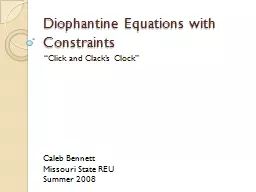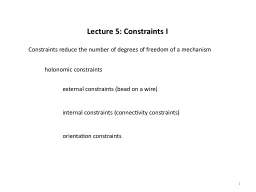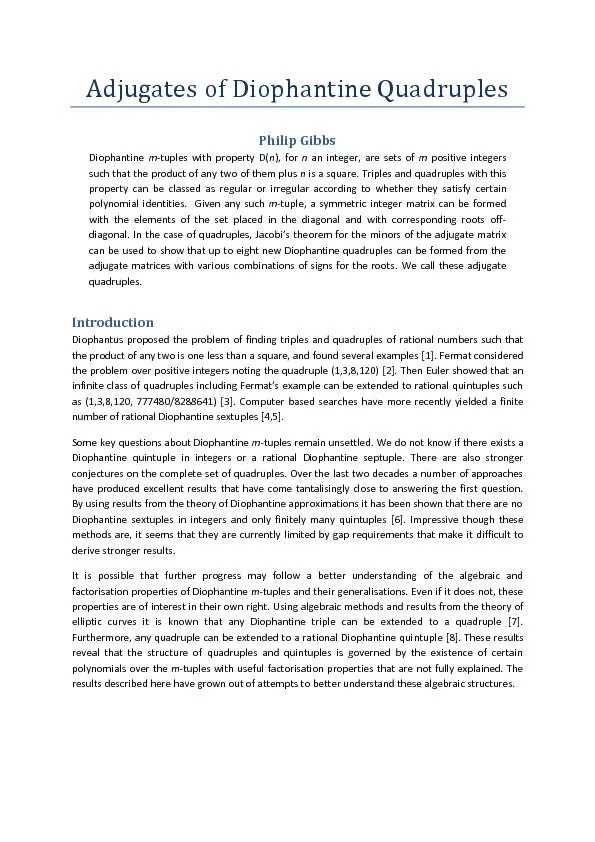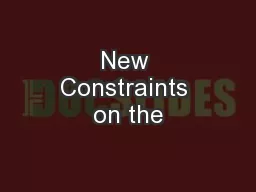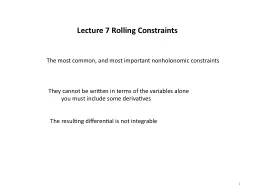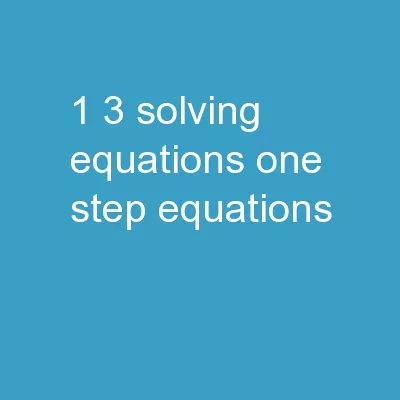PPT-Diophantine Equations with Constraints
Author : liane-varnes | Published Date : 2015-11-07
Click and Clacks Clock Caleb Bennett Missouri State REU Summer 2008 Click and Clacks Clock Click and Clack are the hosts of an automotive repair show called Car
Presentation Embed Code
Download Presentation
Download Presentation The PPT/PDF document "Diophantine Equations with Constraints" is the property of its rightful owner. Permission is granted to download and print the materials on this website for personal, non-commercial use only, and to display it on your personal computer provided you do not modify the materials and that you retain all copyright notices contained in the materials. By downloading content from our website, you accept the terms of this agreement.
Diophantine Equations with Constraints: Transcript
Click and Clacks Clock Caleb Bennett Missouri State REU Summer 2008 Click and Clacks Clock Click and Clack are the hosts of an automotive repair show called Car Talk on National Public Radio Each week Click and Clack pose a brainteaser to their listeners and those listeners who submit correct answers to the problem have a chance of winning a prize. SAGE: Whitebox Testing Check for Crashes (AppVerifier) Code Coverage (Nirvana) Generate Constraints (TruScan) Solve Constraints (Z3) Input0 Coverage Data Constraints Input1 Input2 … InputN MS holonomic. constraints. external constraints (bead on a wire). internal constraints (connectivity constraints). orientation . constraints. 1. Constraints reduce the number of degrees of freedom of a mechanism. Objectives. After completing this module you will be able to…. Apply global timing constraints to a simple synchronous design. Use the Xilinx Constraints Editor to specify global timing constraints. TOPICS TO BE . DISCUSSED. DEFINITION OF CONSTRAINTS. EXAMPLES OF CONSTRAINTS. TYPES OF CONSTRAINTS WITH EXAMPLES. . CONSTRAINTS. In order to solve a set of differential equations for the motion of a system of n-particles, we have to impose certain restrictions on the positions and velocities of the particles of the system. . Diophantine optics in interferometry:. Laboratory performances of the . chessboard phase shifter. Daniel Rouan. , Damien Pickel, Jean-Michel Reess, Olivier Dupuis – LESIA . Didier Pelat – LUTH. Fanny Chemla, Mathieu Cohen – GEPI. Michael Kandefer and Stuart C. Shapiro. University at Buffalo. Department of Computer Science and Engineering. Center for Multisource Information Fusion. Center for Cognitive Science. {mwk3,shapiro}@. Adjugat es Philip Gibbs Diophantine m - tuples with property D( n ) , for n an integer, are sets of m positive integers such that the product of any two of them plus n is a square. Triples and qu Acceleration of Quasar-Driven Galactic Winds. and on the . Density Structure of the CGM. Jonathan Stern (MPIA. ). Alexander von Humboldt Fellow. May 2016. Papers. :. 1. Stern, . Laor. & Baskin (2014a), MNRAS... 2. What do we need to do?. Figure out what and how to simplify. Build a physical model that we can work with. Once that is done, we know how to proceed. although it may be difficult. 3. There are lots of models of the human body designed for multiple purposes. The most common, and most important nonholonomic constraints. They cannot be written in terms of the variables alone. you must include some derivatives. The resulting differential is not integrable. Daniel Paul Tyndall. 4 March 2010. Department of Atmospheric Sciences. University of Utah. Salt Lake City, UT. Outline. Introduction. Literature Review. 2DVar/3DVar Analysis Methodologies. Strong and Weak Constraints. Examples:. . 1). . . x 3 = 15. . 2) p – 5 = 20. 3) 2d = 16. 4). . = 24. . Multi-Step Equations. Examples—. 5). 2p 15 = 29. 6). 14 – 3n = -10. 7). 27 = -9(y 5). 8). 7a – 3a 2a – a = 16. Katherine Wu. the . absolute value. of a number is its distance from 0 on a number line. distance is nonnegative so the absolute value of a number is always positive. symbol |x| is used to represent the absolute number of a number x. from. the . high. . energy. . universe. Denis . WOUTERS. Service de Physique des Particules. Supervisor. : Pierre BRUN. D. Wouters and P. Brun, PRD, 2012, . Irregularity. in . g. -ray. source .
Download Document
Here is the link to download the presentation.
"Diophantine Equations with Constraints"The content belongs to its owner. You may download and print it for personal use, without modification, and keep all copyright notices. By downloading, you agree to these terms.
Related Documents

